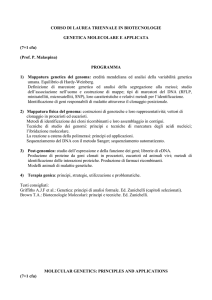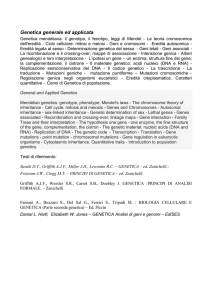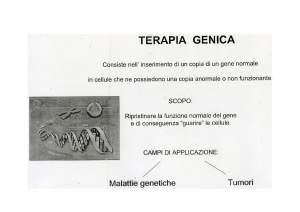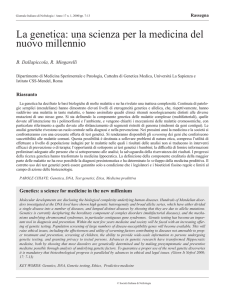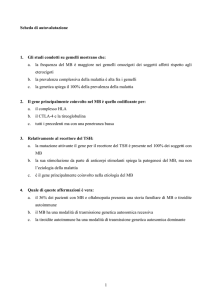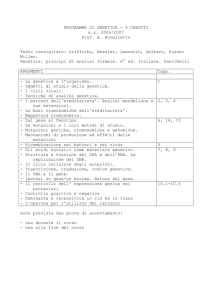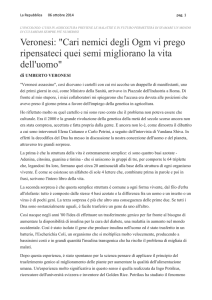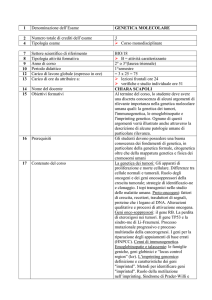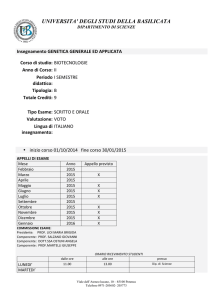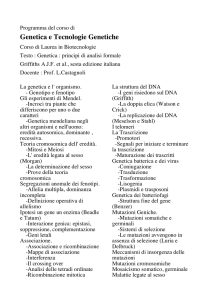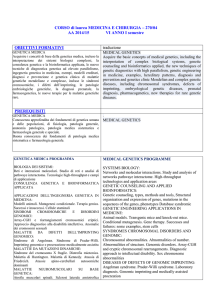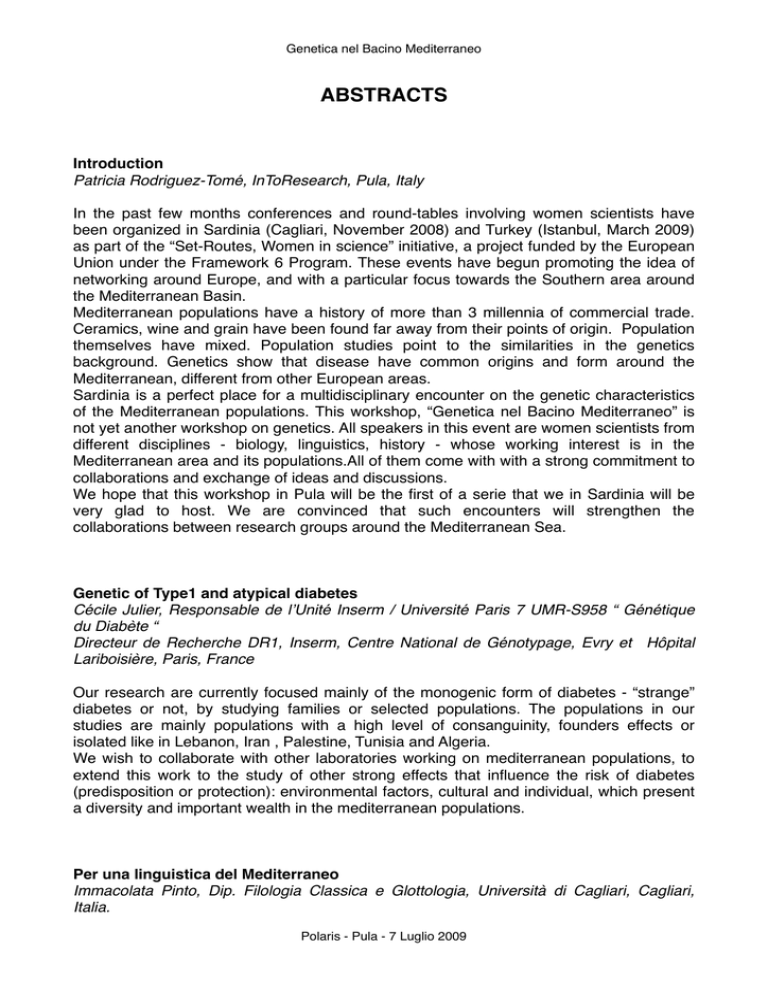
Genetica nel Bacino Mediterraneo
ABSTRACTS
Introduction
Patricia Rodriguez-Tomé, InToResearch, Pula, Italy
In the past few months conferences and round-tables involving women scientists have
been organized in Sardinia (Cagliari, November 2008) and Turkey (Istanbul, March 2009)
as part of the “Set-Routes, Women in science” initiative, a project funded by the European
Union under the Framework 6 Program. These events have begun promoting the idea of
networking around Europe, and with a particular focus towards the Southern area around
the Mediterranean Basin.
Mediterranean populations have a history of more than 3 millennia of commercial trade.
Ceramics, wine and grain have been found far away from their points of origin. Population
themselves have mixed. Population studies point to the similarities in the genetics
background. Genetics show that disease have common origins and form around the
Mediterranean, different from other European areas.
Sardinia is a perfect place for a multidisciplinary encounter on the genetic characteristics
of the Mediterranean populations. This workshop, “Genetica nel Bacino Mediterraneo” is
not yet another workshop on genetics. All speakers in this event are women scientists from
different disciplines - biology, linguistics, history - whose working interest is in the
Mediterranean area and its populations.All of them come with with a strong commitment to
collaborations and exchange of ideas and discussions.
We hope that this workshop in Pula will be the first of a serie that we in Sardinia will be
very glad to host. We are convinced that such encounters will strengthen the
collaborations between research groups around the Mediterranean Sea.
Genetic of Type1 and atypical diabetes
Cécile Julier, Responsable de lʼUnité Inserm / Université Paris 7 UMR-S958 “ Génétique
du Diabète “
Directeur de Recherche DR1, Inserm, Centre National de Génotypage, Evry et Hôpital
Lariboisière, Paris, France
Our research are currently focused mainly of the monogenic form of diabetes - “strange”
diabetes or not, by studying families or selected populations. The populations in our
studies are mainly populations with a high level of consanguinity, founders effects or
isolated like in Lebanon, Iran , Palestine, Tunisia and Algeria.
We wish to collaborate with other laboratories working on mediterranean populations, to
extend this work to the study of other strong effects that influence the risk of diabetes
(predisposition or protection): environmental factors, cultural and individual, which present
a diversity and important wealth in the mediterranean populations.
Per una linguistica del Mediterraneo
Immacolata Pinto, Dip. Filologia Classica e Glottologia, Università di Cagliari, Cagliari,
Italia.
Polaris - Pula - 7 Luglio 2009
Genetica nel Bacino Mediterraneo
Il Mediterraneo è stato da sempre oggetto di particolare interesse per diversi studiosi
appartenenti a più ambiti di ricerca. Tuttavia, tale area meriterebbe un maggior
approfondimento anche da un punto di vista linguistico. Infatti, moltissimi sono i contatti
che si sono avuti nella regione mediterranea sin dalla preistoria. Nello specifico, sarebbe
utile appurare quanto tali contatti abbiano influito sullʼassetto attuale delle lingue del
Mediterraneo. Come vedremo, negli ultimi ventʼanni alcuni passi in avanti sono stati fatti,
ma ancora molta strada deve essere percorsa. È necessario infatti ridefinire metodi,
strumenti e prospettive di ricerca, al fine di ridare maggiore consistenza allʼipotesi di una
eventuale area linguistica panmediterranea.
Genetica della Sclerosi Multipla in Sardegna
Eleonora Cocco, centro di Sclerosi Multipla dellʼUniversitaʼ di Cagliari, Cagliari, Italia
La sclerosi multipla (SM) è una malattia autoimmune demielinizzante del sistema nervoso
centrale, causa comune di disabilità nel giovane adulto. La patologia presenta una
distribuzione geografica caratteristica e segue la latitudine, infatti incidenza e prevalenza
aumentano in entrambi gli emisferi man mano che ci si allontana dallʼequatore.
Unʼeccezione a questa regola è rappresentata dalla Sardegna, unʼisola del mediterraneo
caratterizzata, nonostante la sua posizione geografica, da una elevatissima prevalenza di
malattia. Inoltre anche altri disordini autoimmuni come il diabete mellito di tipo 1 (T1D)
sono molto frequenti nellʼisola. Recentemente è stato osservato che i pazienti SM Sardi
sono ad alto rischio per T1D e questo supporta lʼipotesi di un elevato carico genetico
predisponente allʼautoimmunità nellʼisola. Inoltre negli ultimi 50 anni in Sardegna è stato
osservato un incremento dellʼincidenza associato ad una riduzione dellʼetà dʼesordio.
La modesta ereditabilità della SM riflette lʼeffetto di una complessa interazione tra fattori
genetici e fattori ambientali. In particolare nel modello animale di SM la malattia sembra
essere regolata da molti geni (probabilmente più di 100) ognuno con un piccolo effetto.
Studi sullʼuomo hanno suggerito una situazione simile.
Nonostante importanti sforzi in questo ambito, lʼunico fattore genetico legato alla malattia è
rimasto per decenni lʼHLA. Recentemente sono stati introdotti anche nella SM degli studi
in cui, tramite metodiche innovative, si analizza in dettaglio lʼintero genoma umano (con i
cosiddetti “genome wide association studies”) alla ricerca di geni associati alla malattia.
Questi hanno permesso negli ultimi due anni di identificare nuovi geni di suscettibilità nella
SM, in particolare sono stati inequivocabilmente dimostrati essere in associazione con la
malattia (nonostante ognuno abbia un minimo effetto) i geni che codificano per le seguenti
proteine: recettore alfa dellʼinterleukina 2 (IL2RA), recettore dellʼinterleukina 7 (IL7R),
CLEC16A (KIAA0350) e CD58.
I progressi nelle tecnologie di genotipizzazione e una migliore comprensione della struttura
funzionale del genoma umano, insieme al miglioramento della definizione del fenotipo di
malattia, possono costituire attualmente gli strumenti adatti per identificare i geni coinvolti
nella patogenesi della SM.
La Sardegna è un isolato genetico: la popolazione attuale mostra evidenza di effetto
fondatore, è il risultato di una fissazione di alleli e aplotipi rari o assenti altrove e non
mostra una eterogeneità genetica su larga scala. I Sardi sono quindi la popolazione ideale
per studiare malattie autoimmuni complesse quali la SM. La genetica della SM in
Sardegna è stata ampiamente studiata negli ultimi decenni e i risultati ottenuti verranno
discussi.
Polaris - Pula - 7 Luglio 2009
Genetica nel Bacino Mediterraneo
Disease Gene Hunt in Turkey
Asli Tolun, Department of Molecular Biology and Genetics, Bogazici University, Istanbul,
Turkey.
Within the scope of the Human Genome Project (HGP), the total human genetic
information (genomic sequence) has been obtained. The most significant contribution of
the generated data was to provide the basic genomic information that will facilitate the
deciphering of the functions of our genes. So far, functions of only a fraction of our genes
have been described, while the majority of the genes are classified unknown. The main
purpose of “proteomics”, the most important research area post HGP, is to decipher the
functions of our genes. The most certain route to the identification of the function of a gene
is via investigating the clinical manifestations in individuals (patients) with defects in that
gene. The genes responsible for rather frequent monogenic diseases have been identified
already, and at present human genetics research is focusing on rare disorders. To identify
a rare disease gene, first the gene is localized and subsequently those genes at the locus
that are assessed as good candidates are analyzed for mutations in affected individuals.
Detection of a mutation in a candidate gene of a patient would ascertain that it is the gene
responsible for the disease. This would reveal the molecular basis of the disease and the
function (if unknown) of the gene. Future work would include the investigation of the genes
that interact with the disease gene and of the molecular mechanisms the gene plays a role
in. Other contributions of the research are the training of young scientists and contributing
to scientific research that utilizes the genetic resources of our country. Once the gene is
identified, genetic counseling service could be offered for pregnancies at risk. In addition,
whether other diseases with similar clinical manifestations also result from defects in the
same gene could be investigated. Also, patent application can be done for possible means
of cure or treatment that could be developed only after the elucidation of the molecular
basis of a disease
In Anatolian families, hundreds of rare diseases are observed. Some of those diseases are
novel. The research area of our team is to define new gene functions by identifying new
disease genes. Due to the high rate of consanguineous marriages, most of the diseases
are inherited in an autosomal recessive fashion. We have already published our results on
the identification of the genes responsible for pulmonary alveolar microlithiasis and a
recessive split-hand/foot malformation. Other genes identified are for azoospermia,
arthrogryposis multiplex and microhydranencephaly. We are still in search of genes
responsible for another microhydranencephaly, spastic paraplegia and rare neurological
diseases. Having good genetic material available is opposed by the labor-intensive and
expensive methods and the dependency on good clinical evaluations.
Il mito della purezza delle origini ad Atene.
Elisabetta Poddighe, Dip. Filologia Classica, Glottologia e Scienze Storiche dell'Antichità e
del Medioevo, Università di Cagliari, Cagliari, Italia
Il mito degli Ateniesi purosangue fu al centro della ideologia democratica ateniese tra V e
IV sec. a.C., quando esso operò in funzione della determinazione di Atene di limitare la
cittadinanza e la sovranità politica ai soli discendenti di «sangue puro». Lo studio della
documentazione rivela che tale mito non trovi invece alcun fondamento nella mentalità
ateniese del secolo precedente, il sesto, quando lʼazione politica dei grandi riformatori
Polaris - Pula - 7 Luglio 2009
Genetica nel Bacino Mediterraneo
democratici, Solone e Clistene, appare al contrario contrassegnata da un volontà di
apertura e di integrazione nei confronti degli «impuri».
Molecular investigation of genetic disorders in Tunisia, current situation and
perspectives
Sonia Abdelhak, for the Research Unit Molecular Investigation of Genetic Orphan Disease
and Collaborators, Institut Pasteur de Tunis, Tunisia
Tunisian population, like other North African populations, is characterized by its
heterogeneous ethnic background and a high rate of consanguinity. The rate of
consanguineous mating is estimated to 33% in northern Tunisia. Depending on the studied
area, this rate reaches over 60%. This can be explained by the fact that endogamy is
culturally favoured. In consequence of the high rate of inbreeding, there is an increase in
the prevalence of recessive genetic disorders. During the last 10 years our research unit
contributed to the molecular characterisation of several genetic diseases in Tunisia
including Fanconi anaemia, idiopathic BCGitis, type I megaloblastic anaemia,
epidermolysis bullosa, palmo-plantar hyper-keratosis. Although different diseases are
studied, a standardized strategy has been adopted. In a first step, patients and their
families are typed with microsatellite markers flanking the already known genes to assess
linkage to these candidates using homozygosity mapping. In a second step mutation
screening is performed by direct sequencing of the coding region of the gene of interest.
Despite the relatively small size of the Tunisian population, clinical and genetic
heterogeneity is generally observed. One of the major achievements was circumventing
liver biopsies in infants for the diagnosis of glycogenosis by developing a simple molecular
tool.
More recently we started investigation of multifactoriel diseases, including type II diabetes.
We have shown familial aggregation and excess maternal transmission of type 2 diabetes
(T2D) in the Tunisian population and we investigated involvement of genetic variations in
susceptibility to type II diabetes or its complications. Through a New Partnership for
Africaʼs Development/ North African Biotechnology Network (NEPAD/NABNet) project, on
investigation of T2D in North African Population, we aim to exchange experience with
other colleagues and develop capacities in the field of genetics of non communicable
diseases.
In the post-genomic era and taking into account the geographical, historical, socio-cultural
and economic context of southern Mediterranean countries, development of strategies for
better prevention of genetic diseases should be discussed and set up not only at the
national but also at the regional level.
Information content of connections determines network topology: The case of
transcriptional gene regulatory networks and outlook for microRNA. Ayse Erzan, Department of Physics, Faculty of Sciences and Letters, Istanbul Technical
University, Istanbul, Turkey and Akdeniz University, Antalya, Turkey
Many of the presently observed complex patters and structures in living beings have
emerged spontaneously, without the need for evolutionary selection pressure, merely as a
consequence of the possibilities offered by the laws of physics, chemistry and
combinatorics, with subsequent selection leading to the fine tuning of these already
Polaris - Pula - 7 Luglio 2009
Genetica nel Bacino Mediterraneo
complex formations. We have demonstrated that the topological properties of
transcriptional gene regulatory networks can be reproduced on the basis of a random
sequence-matching rule, given the appropriate length distributions corresponding to the
information content of the binding sequences. We argue that RNA interference and the
role played by micro-RNA in gene regulation can also be understood on purely
probabilistic grounds.
Polaris - Pula - 7 Luglio 2009

